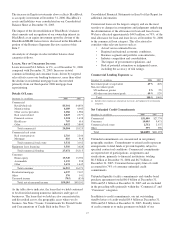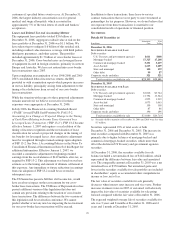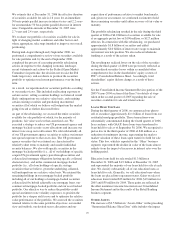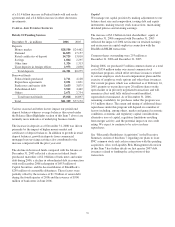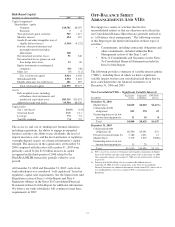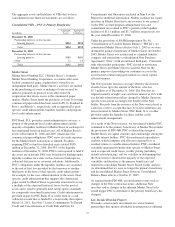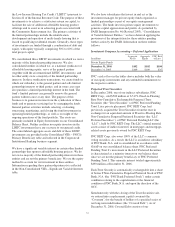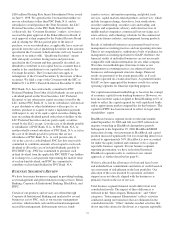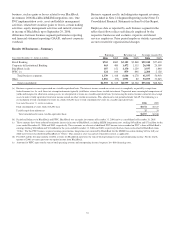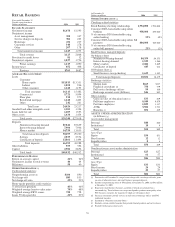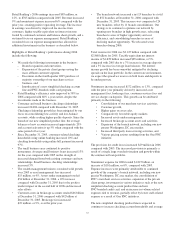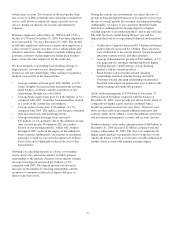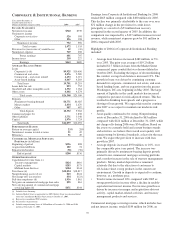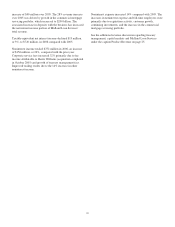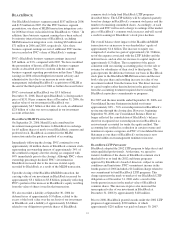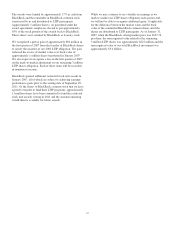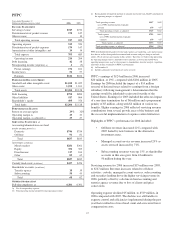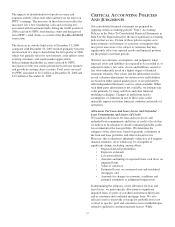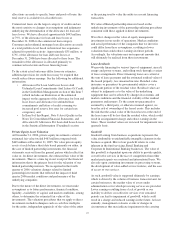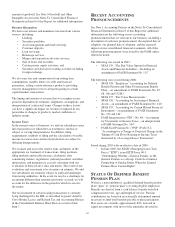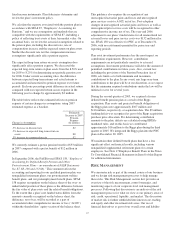PNC Bank 2006 Annual Report Download - page 47
Download and view the complete annual report
Please find page 47 of the 2006 PNC Bank annual report below. You can navigate through the pages in the report by either clicking on the pages listed below, or by using the keyword search tool below to find specific information within the annual report.Retail Banking’s 2006 earnings increased $83 million, or
12%, to $765 million compared with 2005. Revenue increased
9% and noninterest expense increased 6% compared with the
prior year, creating positive operating leverage. The increase
in earnings was driven by improved fee income from
customers, higher taxable-equivalent net interest income
fueled by continued customer and balance sheet growth, and a
sustained focus on expense management. Retail Banking’s
sustained focus on expense management has allowed for
additional investments in the business as described below.
Highlights of Retail Banking’s performance during 2006
include the following:
• We made the following investments in the business:
– Branch expansion and renovation,
– Expansion of the private client group serving the
mass affluent customer segment,
– Execution on the fourth quarter 2005 purchase of
majority ownership of our merchant services
business, and
– Introduction of a new simplified checking account
line and PNC-branded credit card program.
• Retail Banking’s efficiency ratio improved to 58% in
2006 compared with 60% a year earlier, despite the
investments made in the business.
• Consumer and small business checking relationships
increased 20,000 compared with December 31, 2005.
Checking relationship growth has been mitigated by our
focus on consolidating low-activity and low-balance
accounts, while seeking higher quality deposits. Since the
launch of our new simplified product line, the average
balances of new accounts increased approximately 20%
and account activation is up 5% when compared with the
same period of last year.
• Since December 31, 2005, consumer-related checking
households using online banking increased 10% and
checking households using online bill payment increased
97%.
• The small business area continued its positive
momentum. Average small business loans increased 13%
for the year compared with 2005 on the strength of
increased demand from both existing customers and new
relationships. Small business checking relationships
increased 3%.
• The wealth management business sustained solid growth
over 2005 as asset management fees increased
$15 million, or 4%. Assets under management totaled
$54 billion at December 31, 2006, a 10% increase
compared with December 31, 2005 due to the positive
market impact in the second half of 2006 and increased
sales efforts.
• Customer assets in brokerage accounts totaled $46 billion
at December 31, 2006 compared with $42 billion at
December 31, 2005. Brokerage fees increased
$19 million, or 9%, over the prior year.
• The branch network increased a net 13 branches to a total
of 852 branches at December 31, 2006 compared with
December 31, 2005. This increase was comprised of 24
new branches, offset by 11 branch consolidations. Our
strategy is to continue to optimize our network by
opening new branches in high growth areas, relocating
branches to areas of higher opportunity and cost
efficiency, and consolidating branches in areas of
declining market opportunity. We relocated seven
branches during 2006.
Total revenue for 2006 was $3.125 billion compared with
$2.868 billion for 2005. Taxable-equivalent net interest
income of $1.678 billion increased $85 million, or 5%,
compared with 2005 due to a 7% increase in average deposits
and a 5% increase in average loan balances. Net interest
income growth has been somewhat mitigated by declining
spreads on the loan portfolio. In the current rate environment,
we expect the spread we receive on both loans and deposits to
be under pressure.
Noninterest income increased $172 million, or 13%, compared
with the prior year primarily driven by increased asset
management fees, brokerage fees, consumer services fees and
service charges on deposits. This growth can be attributed
primarily to the following:
• Consolidation of our merchant services activities,
• Customer growth,
• Higher gains on asset sales,
• Comparatively favorable equity markets,
• Increased assets under management,
• Increased brokerage account assets and activities,
• Expansion of the branch network, including our new
greater Washington, DC area market,
• Increased third party loan servicing activities, and
• Various pricing actions resulting from the One PNC
initiative.
The provision for credit losses increased $29 million in 2006
compared with 2005. The increased provision is primarily a
result of a single large overdraft situation and growth within
the commercial loan portfolio.
Noninterest expense for 2006 totaled $1.827 billion, an
increase of $101 million, or 6%, compared with 2005.
Expense increases were primarily attributable to continued
growth of the company’s branch network, including our new
greater Washington, DC area market, the consolidation of
PNC’s merchant services activities, expansion of the private
client group, investments in various initiatives such as the new
simplified checking account product line and new
PNC-branded credit card, and an increase in volume-related
expenses tied to revenue, partially offset by lower staff-related
expense as a result of One PNC initiatives.
The new simplified checking product line is expected to
continue to increase checking account households and average
37


